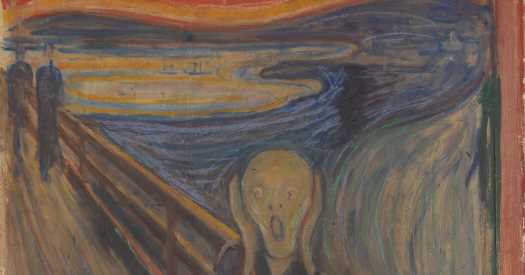Edvard Munch’s “The Scream,” from 1893, is one of the world’s most famous paintings, but for years art historians have mostly ignored a tiny inscription, written in pencil, at the upper left corner of its frame, reading: “Could only have been painted by a madman.”
Who wrote the sentence there? Some thought a disgruntled viewer might have vandalized the work while it was in a gallery; others imagined it was the artist himself who had jotted the enigmatic sentence. But then why?
Curators at Norway’s National Museum of Art, Architecture and Design, which owns the artwork, announced Monday in Oslo that they have determined that the text was indeed written by the artist.

“It’s been examined now very carefully, letter by letter, and word by word, and it’s identical in every way to Munch’s handwriting,” said Mai Britt Guleng, the museum’s curator of old masters and modern paintings, who was in charge of the research. “So there is no more doubt.”
Munch painted four versions of “The Scream” from 1893 to 1910, depicting a skeletal figure on a bridge holding his face while screaming in agony. The first version, painted in tempera on panel with pastels, is the one owned by the National Museum, and is the only one that bears this inscription.
In his diary, Munch wrote that the painting was inspired by “a gust of melancholy.” It has become a symbol of existential angst and called the Mona Lisa of modern art, and has been reproduced and copied widely. (Two other originals are in Norwegian museums; an 1895 version, in pastel on cardboard, is owned by a private collector.)
The text, “Could only have been painted by a madman,” isn’t large enough for most people to notice, especially when it’s presented in the museum behind glass, Guleng said. To study it, the researchers needed to use infrared photography to make it more legible. “He didn’t write it in big letters for everyone to see,” she said. “You really have to look hard to see it. Had it been an act of vandalism, it would have been larger.”
Lasse Jacobsen, a research librarian at the Munch Museum in Oslo who works with Munch’s collected writings, confirmed Guleng’s findings. The infrared photographs, he said, made it “much easier to see the words, and there are some letters in his handwriting that are really distinct, like the N, or the D, which turns up at the end. So when I saw it there I thought, ‘This is Munch.’”
The 2008 Munch catalog raisonné, a comprehensive study of his works by the art historian Gerd Woll, suggested that the phrase had been scrawled by a vandal. “At least that is how it was perceived in 1904,” when it was exhibited in Copenhagen, she writes, “that a tactless hand has written in pencil.” In an email to The New York Times, Woll said that the new evidence from Guleng “strongly points to Munch himself as the writer.”
While the National Museum in Norway was in the process of restoring and examining the work in preparation for the opening of its new museum in 2022, Guleng took the opportunity to resolve the question about the text.
“It was strange to me that there was such little curiosity about this inscription, because it is a very peculiar thing to write on your own painting,” she said.
Munch probably wrote the sentence on his painting in 1895, according to Guleng, after his exhibition of new work at the Blomqvist gallery in Oslo. During a debate about the exhibition at the University of Oslo’s Students Association one night, a medical student, Johan Scharffenberg said the artwork gave him reason to question the artist’s mental state, calling Munch abnormal and a “madman.” Munch was deeply hurt, said Jacobsen, and wrote about it even decades later.
Guleng believes the inscription is written with irony and reflects both pain at being attacked and fear of being regarded as mentally ill. “By writing this inscription in the clouds, he took possession, in a way, or he took control of how he was to be perceived and understood,” she said.
“Linking the inscription to the 1895 exhibition and the insinuations by Scharffenberg also gives a possible explanation for why Munch should have written this ‘statement’ on his painting,” Woll said in her email. “But it is still uncertain when it was written.”
Madness was often linked to artistic expression in the 19th century — and part of the mythic status of both artists — said Maite van Dijk, one of the curators of the 2015 “Munch/Van Gogh” exhibition at the Van Gogh Museum in Amsterdam.
“By writing on the painting itself, Munch is playing with this part of his image,” said van Dijk. “It’s very ambiguous what he’s doing. It could be a rhetorical question, or it could be a statement. Who is asking the question? Is he paraphrasing the critic, or the public? That’s part of the whole thing Munch is doing. He’s speaking in mysteries and giving no clear answers.”
Source: Read Full Article
